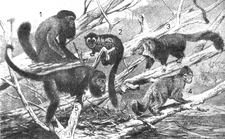New World monkey
| New World monkeys[1] | ||||||||||||||
|---|---|---|---|---|---|---|---|---|---|---|---|---|---|---|
 |
||||||||||||||
| Scientific classification | ||||||||||||||
|
||||||||||||||
| Families | ||||||||||||||
|
Cebidae |
The New World monkeys are the four families of primates that are found in Central and South America: Cebidae, Aotidae, Pitheciidae and Atelidae. The four families are ranked together as the Platyrrhini parvorder. They differ from other groupings of monkeys and primates, such as the Old World monkeys and the apes.
Contents |
Characteristics
New World monkeys are small to mid-sized primates, ranging from the Pygmy Marmoset (the world's smallest monkey), at 14 to 16 cm (5.5 to 6.3 in) and a weight of 120 to 190 grams (4.2 to 6.7 oz) to the Southern Muriqui, at 55 to 70 cm (22 to 28 in) and a weight of 12 to 15 kg (26 to 33 lbs). New World monkeys differ slightly from Old World monkeys in several aspects. The most prominent difference is the nose, which is the feature used most commonly to distinguish between the two groups. The scientific name for the New World monkeys, Platyrrhini, means "flat nosed". The noses of New World monkeys are flatter than the narrow noses of the Old World monkeys, and have side-facing nostrils. Male New World monkeys (except for the howler monkeys of genus Alouatta[2]) also lack the trichromatic vision of Old World monkeys.[3] Platyrrhines also differ from Old World monkeys in that they have twelve premolars instead of eight. New World monkeys in the family Atelidae are the only primates with tails that are prehensile. Many New World monkeys are small and almost all are arboreal, so knowledge of them is less comprehensive than that of the more easily observed Old World monkeys. Unlike most Old World monkeys, many New World monkeys form monogamous pair bonds, and show substantial paternal care of young.
Origin
About 40 million years ago the Simiiformes infraorder split into parvorders Platyrrhini (New World monkeys—in South America) and Catarrhini (apes and Old World monkeys—in Africa).[4] The Platyrrhini are currently conjectured to have migrated across the Atlantic Ocean to South America on a raft of vegetation similar to the vast pieces of floating mangrove forest that storms occasionally break off from the tropical African coast.[5] At that time the Atlantic Ocean was less than the present 2,800 km (1,700 mi) wide.
Classification
- ORDER PRIMATES
- Suborder Strepsirrhini: lemurs, lorises, etc.
- Suborder Haplorrhini: tarsiers, monkeys and apes
- Infraorder Tarsiiformes
- Family Tarsiidae: tarsiers
- Infraorder Simiiformes
- Parvorder Platyrrhini: New World monkeys
- Family Cebidae: marmosets, tamarins, capuchins and squirrel monkeys
- Family Aotidae: night or owl monkeys (douroucoulis)
- Family Pitheciidae: titis, sakis and uakaris
- Family Atelidae: howler, spider and woolly monkeys
- Parvorder Catarrhini: Old World monkeys, apes and humans
- Parvorder Platyrrhini: New World monkeys
- Infraorder Tarsiiformes
References
- ↑ Groves, C. (2005-11-16). Wilson, D. E., and Reeder, D. M. (eds). ed.. Mammal Species of the World (3rd edition ed.). Johns Hopkins University Press. pp. 128-152. ISBN 0-801-88221-4. http://www.bucknell.edu/msw3.
- ↑ Jacobs, G. H.; Neitz, M.; Deegan, J. F.; Neitz, J. (1996). "Trichromatic colour vision in New World monkeys". Nature 382: 156–158. doi:.
- ↑ Sean B. Carroll (2006). The Making of the Fittest. W.W. Norton and Company. ISBN 9780393061635.
- ↑ Robert W. Shumaker & Benjamin B. Beck (2003). Primates in Question. Smithsonian Institute Press. ISBN 1588341763.
- ↑ Sellers, Bill (2000-10-20). "Primate Evolution" (PDF) 13-17. University of Edinburgh. Retrieved on 2008-10-23.
Further reading
- Schneider, H. (2000). "The current status of the New World Monkey phylogeny". Anais da Academia Brasileira de Ciências 72: 165–172. doi:.
- Opazo, J. C.; et al. (2006). "Phylogenetic relationships and divergence times among New World monkeys (Platyrrhini, Primates)". Molecular Phylogenetics and Evolution 40 (1): 274–280. doi:.